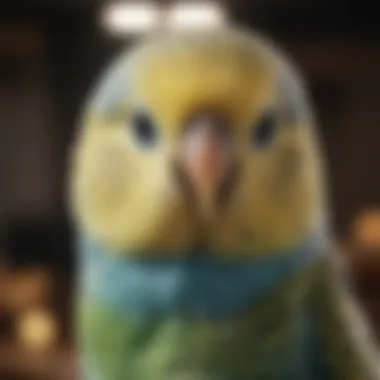Budgies Breeding Cage: A Comprehensive Guide


Intro
Creating an optimal breeding environment for budgerigars is essential for successful breeding. Understanding their behavior, needs, and the equipment required can significantly improve the chances of producing healthy offspring. This guide emphasizes the key components of a breeding cage, including dimensions, materials, and enriching activities. All aspects contribute to a healthier, more productive breeding process for your budgies.
Understanding Your Pet
Pet Behavior Basics
Budgerigars, or budgies, display unique behaviors, especially during breeding. They establish hierarchies, show preferences for certain perches, and can be more vocal as they prepare to mate. Recognizing these behaviors is critical for creating a suitable environment. Provide a quiet, stress-free space with ample room to move freely.
Common Breed Characteristics
Budgies are social creatures. They often thrive in pairs but can also breed in groups. They are known for their instinctual tendencies to create nests. Their color variations can range from blue to green, each having its specific characteristics. Behavioral differences may also arise depending on their lineage.
Species-Specific Needs
Ensuring a breeding cage meets the species-specific needs is vital. Budgies prefer spacious cages with horizontal bars to facilitate climbing. They often require nesting boxes to encourage breeding behaviors. Providing a calm environment free from loud noises is equally important.
Pet Care and Maintenance
Feeding Guidelines
A balanced diet is essential for breeding budgies. High-quality seed mixes enriched with vitamins and minerals support reproductive health. Fresh fruits and vegetables also play a significant role in their nutrition. Ensure clean, fresh water is always available.
Grooming Essentials
Regular grooming helps maintain a budgie's feathers and overall health. Provide cuttlebone or mineral blocks for beak maintenance. Occasionally, baths help keep their feathers clean. Grooming has the added benefit of fostering trust between you and your bird.
Hygiene Practices
Maintaining a clean cage environment is critical for budgie health. Remove uneaten food daily and clean perches, nesting boxes, and toys weekly. Use non-toxic cleaning agents to sanitize. A clean space reduces the risk of diseases and promotes overall well-being.
Training and Development
Basic Commands and Skills
Training budgies to respond to basic commands can enhance communication. Simple commands can include "step up" or "come here." Repetition and patience are crucial for effective training.
Behavioral Training Techniques
Positive reinforcement works well with budgies. Utilize treats to reward desired behavior. Avoid harsh methods, as they can lead to stress, and negatively affect breeding. Instead, focus on building trust through gentle interactions.
Addressing Common Behavior Issues
Common issues include excessive screaming or feather-plucking. Identifying stressors can help manage these behaviors. Environmental enrichment, like toys and social interaction, plays a vital role in reducing anxiety.
Health and Wellness
Routine Vet Check-ups
Regular veterinary visits are important for monitoring health. Schedule yearly check-ups and consult a vet if you notice changes in behavior or appetite. Early detection of health issues ensures timely intervention.
Vaccination Needs
Budgies should be vaccinated against common avian diseases. Discuss vaccination schedules with your vet. Keeping records of vaccines helps safeguard your birds’ health.
Recognizing Signs of Illness
Be vigilant for signs of illness such as lethargy, changes in droppings, or ruffled feathers. These can indicate health issues requiring prompt veterinary attention. Maintaining an observant eye helps catch problems early.
Enrichment and Activities
Indoor vs. Outdoor Activities


Budgies thrive with varied activities. Indoor spaces can be enriched with swings, ladders, and perches at different heights. Outdoor time in a safe aviary under supervision also benefits their mental health.
Interactive Toys and Games
Providing interactive toys stimulates their minds. Rotate toys regularly to keep them engaged. Items like foraging toys encourage natural behaviors in a controlled environment.
Socialization Opportunities
Budgies are social animals and benefit from interaction. Introduce them to other budgies gradually. Monitor their interactions to ensure compatibility and avoid aggression.
Proper knowledge about budgie behavior and needs is the cornerstone of successful breeding.
Preface to Budgie Breeding
Breeding budgerigars, or budgies, is not merely a hobby; it is an intricate process that requires a solid understanding of the bird's biology, behavior, and their environmental needs. For pet owners interested in expanding their flock, establishing a proper breeding setup is crucial. This guide will outline critical aspects of budgie breeding, ensuring that readers are well-equipped for successful outcomes.
Understanding Budgies as Pets
Budgies are one of the most popular pet birds worldwide, and for good reason. Their vibrant colors, playful personalities, and relative ease of care make them suitable for families and individuals alike. These birds are social and thrive on interaction, both with their owners and among their peers. Understanding their nature lays the foundation for effective breeding practices.
Budgies exhibit complex social behaviors. They often develop strong bonds with their owners and other budgies. When planning for breeding, it is essential to consider their social structure. In the wild, they live in flocks, which influences their mating habits and success in breeding. Creating an environment that mimics their natural habitat helps. It is possible to enhance their breeding behavior.
The Importance of a Breeding Cage
One of the most critical aspects of breeding budgies is the cage itself. A dedicated breeding cage is essential for factors that contribute to the birds' reproductive success. A suitable cage environment minimizes stress and promotes a sense of security.
A breeding cage should be spacious enough to allow movement and courtship behaviors without hindrance. This space helps the pair feel comfortable and encourages mating rituals. Additionally, the cage must be designed to remain clean and accessible for maintenance, which is vital for the health of the birds.
Furthermore, the breeding cage acts as a controlled environment, where factors like temperature and humidity can be monitored. This control allows owners to optimize conditions that are conducive to breeding, thus improving the chances of successful egg-laying and chick rearing.
A proper breeding environment is key to the health and well-being of the budgies, which in turn, influences their breeding behavior and reproductive success.
Designing the Breeding Cage
Designing a breeding cage for budgerigars is a critical component in nurturing a healthy environment for their reproductive efforts. A well-thought-out design can influence not only the comfort and safety of the birds but also the efficiency of the breeding process. This section will outline essential elements to consider, their benefits, and overarching guidelines that ensure an optimal setup for breeding budgies.
Dimensions and Space Requirements
Appropriate dimensions play a vital role in the breeding cage's effectiveness. Budgies need adequate space to move freely, engage in natural behaviors, and feel secure. A cage with dimensions too small may restrict movements and lead to stress, which can adversely affect breeding.
A typical breeding cage should be at least 24 inches wide, 18 inches deep, and 24 inches tall. However, larger dimensions are always beneficial when possible. Space allows for more nesting boxes, perches, and room for the budgies to fly short distances within the cage. If space allows, opt for wider cages to facilitate better interaction between bonded pairs.
Cage Configuration and Layout
The layout of a breeding cage should promote a harmonious living environment. Essential features of a well-configured cage include designated areas for nesting, feeding, and perching.
Nesting boxes should be placed at a height that is easily accessible to the breeding pair yet away from high traffic areas to minimize disturbances. Additionally, ensure that there's sufficient space for food and water bowls, allowing both birds to eat and drink without competition.
Here are some tips for effective cage configuration:
- Use multiple perches at different heights to allow free movement.
- Include nesting materials like shredded paper or grass in a specific area to encourage natural nesting behavior.
- Position food and water dishes within easy reach but away from the nesting area to reduce contamination.
Maintaining a clear layout supports the birds' social dynamics and encourages successful breeding behaviors.
Material Considerations
Material selection is a fundamental aspect of cage design. The materials used in constructing a breeding cage can impact safety, cleanliness, and the overall environment.
Cages should be made from non-toxic materials to ensure the health of your budgies. Stainless steel, powder-coated metals, and untreated wood are reliable choices. Avoid cages made from plastic, as they can harbor bacteria over time and are not as durable.
Consider the following when choosing materials:
- Easy to clean: Smooth surfaces reduce the buildup of debris and make regular cleaning simpler.
- Durable: Strong materials withstand bird bites and other wear, ensuring longevity.
- Safety: Ensure there are no sharp edges or small openings where the birds could get stuck or injured.
Necessary Equipment for Successful Breeding


Creating a thriving environment for breeding budgerigars necessitates the right equipment. This equipment serves various functions, all contributing to the health and well-being of the birds during the breeding process. The proper setup not only supports the budgies but also facilitates successful mating and raising of chicks. Here, we explore the essential equipment necessary for successful breeding, which includes nesting boxes, food and water supply systems, and appropriate perches and accessories.
Nesting Boxes: Types and Features
Nesting boxes are critical components in a breeding cage, as they provide a safe and secure space for the female budgie to lay eggs and raise her chicks. There are several types of nesting boxes, including wooden, plastic, and metal varieties. Each type has its advantages depending on the needs of the birds and the preferences of the owner.
- Wooden Nesting Boxes: Often preferred due to their natural insulation properties, wooden boxes are durable and can be customized regarding size and entrance hole. They encourage natural behaviors in budgies.
- Plastic Nesting Boxes: These are easier to clean and resistant to mold or bacteria. However, they may not provide the same insulation as wood, so owners need to ensure proper temperature management in the breeding cage.
- Metal Nesting Boxes: Metal options are sturdy and can last long, but they should have a coating that is safe for birds. They can get too hot during summer months, so precautions must be taken.
Selecting the right nesting box is essential for encouraging the female budgie to feel secure. The box should be easy to access for cleaning but also have secure closure to keep the young chicks safe.
Food and Water Supply Systems
Providing proper nutrition and hydration is crucial in breeding settings. A well-designed food and water supply system ensures that the breeding pair and any chicks have continuous access to essential resources. Few options enhance this aspect:
- Automatic Water Dispensers: These are beneficial as they prevent water from contaminating quickly. They are easy to install and offer a consistent supply.
- Feeders: Opt for feeders that minimize waste and keep seeds fresh. Different feeder designs cater to varying seed types, so choose one that suits your feeding method.
- Supplemental Food Items: It’s a good idea to provide additional nutrition sources, such as fresh fruits, vegetables, and calcium supplements. This encourages good health and can aid in reproductive success.
Empowering your budgies with proper nutrition supports their energy needs, especially during the breeding season when they require optimal health.
Perches and Accessories
The right perches and accessories enhance the breeding cage environment. These items offer spaces for budgies to rest, exercise, and engage in natural behaviors:
- Perch Variety: Use perches of different diameters and materials. Natural wood perches are the best as they provide gripping surfaces that help maintain healthy feet. Synthetic perches can be used for variety, but natural options should be prioritized.
- Hiding Places: Items like non-toxic plants or decorative branches can provide secure areas for budgies. Providing a sense of safety can reduce stress and promote breeding behaviors.
- Toys: While not essential, toys can stimulate the birds mentally. Choose simple toys that are safe and engage without leading to frustration.
Access to appropriate perches and accessories allows birds to exhibit natural behaviors, contributing positively to their overall well-being.
Importance of Equipment for Breeding Success: Adequate equipment like nesting boxes, feeding systems, and proper perches profoundly influences breeding outcomes and chick vitality.
In summary, equipping the breeding cage with the right tools is fundamental for successful budgie breeding. Each element plays a role in ensuring comfort, security, and health during this sensitive phase.
Optimal Conditions for Breeding
Creating an optimal breeding environment for budgerigars is essential. Categories such as temperature, humidity, lighting, and noise influence not just the immediate comfort of your birds, but also their overall reproductive success. Understanding how to maintain these conditions can lead to a healthy breeding cycle, resulting in happier birds and possibly more successful hatches.
Temperature and Humidity Levels
Maintaining proper temperature and humidity is crucial for budgie breeding success. Suboptimal levels can hinder fertility and affect chick development. Budgies thrive best in environments ranging from 65°F to 85°F (18°C to 29°C). Higher temperatures can induce stress; conversely, lower temperatures risk illness.
Humidity should ideally sit between 40% to 60%. This range assists in feather maintenance and respiratory health. Too much moisture can lead to mold growth, while excessively dry air can create discomfort.
To monitor these levels, consider using a reliable thermometer and hygrometer. Implementing a heating lamp or a humidifier can help maintain the desired environment. Regularly check these tools to ensure they function correctly.
Lighting Requirements
Correct lighting plays an important role in budgie mood and breeding behavior. Budgies are diurnal creatures that rely on natural cycles of light and darkness to regulate their internal clocks. To replicate natural conditions, aim for about 12 to 14 hours of light each day, coupled with 10 to 12 hours of darkness.
Natural sunlight is beneficial, as it provides essential UV light. However, too much direct sunlight can lead to overheating. Thus, consider placing the cage near a window that offers filtered light.
Alternatively, full spectrum bulbs can simulate outdoor lighting and lessen the adverse effects of inadequate sunlight. Always ensure that their brightness is suitable for the birds, avoiding extreme brightness that may cause discomfort.
Noise and Disturbance Minimization
Budgies, like many birds, can be sensitive to noise and disturbances in their environment. Excessive noise may lead to stress, aggressive behavior, or even affect breeding cycles. Creating a calm space can result in a happier and more productive breeding pair.
To minimize unwanted noise:
- Choose a Quiet Location: Position the cage away from high-traffic areas in your home.
- Soft Background Sounds: If complete silence is not achievable, mellow background music can serve as a calming influence.
- Limit Interactions: When breeding, limit interactions with the birds to avoid causing distress. This includes reducing the frequency of unannounced visits to their space.
In summary, optimal conditions for breeding budgies revolve around careful management of temperature, humidity, lighting, and environmental noise. Establishing these parameters lays the foundation for a successful and healthy breeding process.
Behavioral Considerations in Budgie Breeding
Understanding the behavioral aspects of budgies in a breeding context is paramount for successful breeding practices. These small parrots are inherently social creatures. Their behavior influences not just their ability to mate but also the health of the offspring. Recognizing these dynamics helps pet owners create a conducive environment, facilitating natural breeding behaviors.
The main benefit of focusing on behavioral considerations lies in enhancing the likelihood of successful mating. When budgies feel comfortable and safe, they are more likely to engage in mating rituals. Observing their social dynamics can provide invaluable insights into what they need for optimal conditions.


Social Dynamics During Breeding
Social interactions among breeding pairs significantly impact their reproductive success. Budgies exhibit various social behaviors during the breeding season, which can be an indicator of their readiness to mate. Male budgies often show courtship behaviors, such as bowing and singing, to attract females. These activities are not just instinctual; they serve a critical role in establishing bonds between pairs.
The female's responses are equally important. She may engage in preening and returning calls, signaling her acceptance. If a female budgie shows interest, her body language becomes more open; this might manifest as hopping closer or adopting flattened wings. Monitoring these interactions gives owners essential clues about the health of the bond between the birds.
"Social harmony contributes deeply to the success of breeding in budgies. Observations should be attentive to the sense of companionship that the birds exhibit."
Signs of Mating Behavior
Recognizing signs of mating behavior is crucial for anyone who aims to foster a successful breeding environment. Mating readiness can be observed through physical and behavioral cues. For instance, one common sign in female budgies is the development of a swollen cloacal area, which indicates she may be ready for ovulation.
Other behaviors include:
- Increased vocalizations: Both male and female budgies may become more vocal. The male cranks up his singing as a way to woo the female.
- Feather maintenance: Budgies will spend considerable time preening; this is a way to ensure they look their best.
- Nesting behavior: As the breeding season approaches, you may notice a renewed interest in the nesting box, with both budgies examining the space closely.
Awareness of these signs allows pet owners to prepare the breeding environment adequately and ensure that the conditions align with the needs of the birds.
In summary, grasping the behavioral intricacies of budgie breeding is essential for achieving success. Social dynamics play a key role in pairing, and recognizing mating behaviors gives indicators that signal whether the conditions are appropriate.
Monitoring and Maintenance of the Breeding Cage
Monitoring and maintaining a breeding cage is crucial for both the health of your budgerigars and the success of their breeding efforts. A clean, organized environment contributes to reduced stress levels for the birds, which can enhance their reproductive behaviors. It also helps to prevent the spread of diseases that arise in unsanitary conditions. Regular observation can alert the owner to behaviors or changes in the birds' health that might require attention. Furthermore, proper maintenance ensures that the breeding cage continues to meet the necessary conditions for optimal breeding outcomes.
Regular Cleaning Protocols
Regular cleaning of the breeding cage is non-negotiable. Establish a cleaning schedule that suits the needs of your budgies. Typically, daily tasks include removing uneaten food, soiled bedding, and droppings. This prevents the buildup of harmful bacteria.
Weekly cleaning tasks may include:
- Disinfecting surfaces with bird-safe cleaners
- Cleaning food and water dishes thoroughly
- Replacing bedding material in nesting boxes
Important steps to ensure effective cleaning include:
- Using warm, soapy water and then rinsing thoroughly to remove any residues of cleaning agents
- Allowing the cage to dry completely before reintroducing the birds
"A clean breeding environment is essential for the health of the parent birds and the success of their offspring."
By maintaining a cleaning routine, pet owners can provide a healthier environment that promotes active breeding and raises the survival chances for new chicks.
Health Checks for Breeding Pair
Regular health checks for the breeding pair are essential for detecting any potential issues early. A preventive approach can be more effective than treating problems after they arise.
During inspections, look for the following signs of good health:
- Bright, clear eyes: Dull or cloudy eyes can indicate illness.
- Clean feathers: Birds that groom themselves frequently reflect overall good health.
- Full, rounded body shape: A noticeable weight loss can signal health issues.
Additionally, consider the following practices for health monitoring:
- Keep track of any changes in behavior or eating habits.
- Monitor for any signs of stress or illness, such as excessive feather plucking or lethargy.
If any abnormalities are noticed, consult with a veterinarian experienced in avian care. Early intervention can often make a significant difference in recovery and breeding success. Mindful and thorough health checks will not only facilitate a successful breeding process but also ensure the longevity of the birds involved.
Finale
In the context of breeding budgerigars, the conclusion draws together the essential elements discussed throughout this guide. A well-designed breeding cage, proper equipment, and attention to conditions create a nurturing atmosphere crucial for the health of both the birds and their offspring. This article emphasizes the multifaceted nature of breeding budgies, where every detail contributes to the overall success of the endeavor.
Summary of Key Takeaways
- Cage Design Matters: The dimensions and layout directly affect the well-being and mating behavior of budgies. A spacious, thoughtfully organized cage promotes interaction and comfort.
- Essential Equipment: Nesting boxes, food, and water supplies are vital for successful breeding. Having the right accessories ensures various needs are met, from feeding to nesting.
- Breeding Conditions: Temperature, humidity, and lighting play a significant role in stimulating breeding behaviors. Maintaining these aspects is foundational for a successful breeding environment.
- Behavioral Dynamics: Understanding the social interactions and mating signs in budgies offers insights into their breeding readiness. Monitoring these behaviors can facilitate timely interventions.
"A conducive environment directly influences breeding outcomes. Every component of the breeding cage should align with the needs of the budgerigars."
Future Considerations in Budgie Breeding
As awareness about budgie welfare grows, future breeding practices should focus on sustainability and ethical considerations. This includes understanding the genetic diversity of your breeding pairs and avoiding inbreeding. Additionally, staying informed about advances in pet care, such as improved nutrition and habitat requirements, can further enhance breeding success.
Future breeders should also consider integrating research into behavioral studies and their implications on breeding success. Following these trends, keeping updated with community discussions on platforms like Reddit or joining groups on Facebook will facilitate knowledge sharing.
Lastly, ongoing education is indispensable. Attend workshops, engage with reputable organizations in avian care, and continue learning about best practices in breeding budgies. By doing so, you can ensure that your breeding efforts contribute positively to the budgerigar populace.







